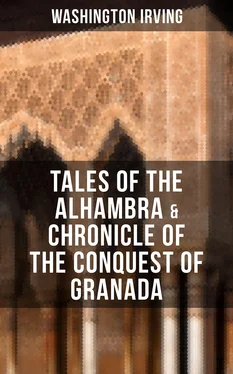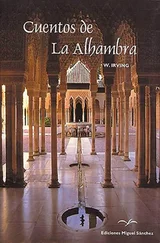On that day, according to Mateo, the whole city is abandoned to revelry. The great alarm bell on the watchtower of the Alhambra (la Torre de la vela), sends forth its clanging peals from morn till night; the sound pervades the whole Vega, and echoes along the mountains, summoning the peasantry from far and near to the festivities of the metropolis. “Happy the damsel,” says Mateo, “who can get a chance to ring that bell; it is a charm to insure a husband within the year.”
Throughout the day the Alhambra is thrown open to the public. Its halls and courts, where the Moorish monarchs once held sway, resound with the guitar and castanet, and gay groups, in the fanciful dresses of Andalusia, perform their traditional dances inherited from the Moors.
A grand procession, emblematic of the taking possession of the city, moves through the principal streets. The banner of Ferdinand and Isabella, that previous relic of the Conquest, is brought forth from its depository, and borne in triumph by the Alferez mayor, or grand standard-bearer. The portable camp-altar, carried about with the sovereigns in all their campaigns, is transported into the chapel royal of the cathedral, and placed before their sepulchre, where their effigies lie in monumental marble. High mass is then performed in memory of the Conquest; and at a certain part of the ceremony the Alferez mayor puts on his hat, and waves the standard above the tomb of the conquerors.
A more whimsical memorial of the Conquest is exhibited in the evening at the theatre. A popular drama is performed, entitled AVE MARIA, turning on a famous achievement of Hernando del Pulgar, surnamed “el de las Hazanas” (he of the exploits), a madcap warrior, the favorite hero of the populace of Granada. During the time of the siege, the young Moorish and Spanish cavaliers vied with each other in extravagant bravadoes. On one occasion this Hernando del Pulgar, at the head of a handful of followers, made a dash into Granada in the dead of the night, nailed the inscription of AVE MARIA with his dagger to the gate of the principal mosque, a token of having consecrated it to the Virgin, and effected his retreat in safety.
While the Moorish cavaliers admired this daring exploit, they felt bound to resent it. On the following day, therefore, Tarfe, one of the stoutest among them, paraded in front of the Christian army, dragging the tablet bearing the sacred inscription AVE MARIA, at his horse’s tail. The cause of the Virgin was eagerly vindicated by Garcilaso de la Vega, who slew the Moor in single combat, and elevated the tablet in devotion and triumph at the end of his lance.
The drama founded on this exploit is prodigiously popular with the common people. Although it has been acted time out of mind, it never fails to draw crowds, who become completely lost in the delusions of the scene. When their favorite Pulgar strides about with many a mouthy speech, in the very midst of the Moorish capital, he is cheered with enthusiastic bravos; and when he nails the tablet to the door of the mosque, the theatre absolutely shakes with the thunders of applause. On the other hand, the unlucky actors who figure in the part of the Moors, have to bear the brunt of popular indignation, which at times equals that of the Hero of La Mancha, at the puppet-show of Gines de Passamonte; for, when the infidel Tarfe plucks down the tablet to tie it to his horse’s tail, some of the audience rise in fury, and are ready to jump upon the stage to revenge this insult to the Virgin.
By the way, the actual lineal descendant of Hernando del Pulgar was the Marquis de Salar. As the legitimate representative of that madcap hero, and in commemoration and reward of this hero’s exploit, above mentioned, he inherited the right to enter the cathedral on certain occasions, on horseback; to sit within the choir, and to put on his hat at the elevation of the host, though these privileges were often and obstinately contested by the clergy. I met him occasionally in society; he was young, of agreeable appearance and manners, with bright black eyes, in which appeared to lurk some of the fire of his ancestors. Among the paintings in the Vivarrambla, on the fete of Corpus Christi, were some depicting, in vivid style, the exploits of the family hero. An old grayheaded servant of the Pulgars shed tears on beholding them, and hurried home to inform the marquis. The eager zeal and enthusiasm of the old domestic only provoked a light laugh from his young master; whereupon, turning to the brother of the marquis, with that freedom allowed in Spain to old family servants, “Come, senor,” cried he, “you are more considerate than your brother; come and see your ancestor in all his glory!”
In emulation of this great Dia de la Toma of Granada, almost every village and petty town of the mountains has its own anniversary, commemorating, with rustic pomp and uncouth ceremonial, its deliverance from the Moorish yoke. On these occasions, according to Mateo, a kind of resurrection takes place of ancient armor and weapons; great two-handed swords, ponderous arquebuses with matchlocks, and other warlike relics, treasured up from generation to generation, since the time of the Conquest; and happy the community that possesses some old piece of ordnance, peradventure one of the identical lombards used by the conquerors; it is kept thundering along the mountains all day long, provided the community can afford sufficient expenditure of powder.
In the course of the day, a kind of warlike drama is enacted. Some of the populace parade the streets, fitted out with the old armor, as champions of the faith. Others appear dressed up as Moorish warriors. A tent is pitched in the public square, inclosing an altar with an image of the Virgin. The Christian warriors approach to perform their devotions; the infidels surround the tent to prevent their entrance; a mock fight ensues; the combatants sometimes forget that they are merely playing a part, and dry blows of grievous weight are apt to be exchanged. The contest, however, invariably terminates in favor of the good cause. The Moors are defeated and taken prisoners. The image of the Virgin, rescued from thraldom, is elevated in triumph; a grand procession succeeds, in which the conquerors figure with great applause and vainglory; while their captives are led in chains, to the evident delight and edification of the spectators.
These celebrations are heavy drains on the treasuries of these petty communities, and have sometimes to be suspended for want of funds; but, when times grow better, or sufficient money has been hoarded for the purpose, they are resumed with new zeal and prodigality.
Mateo informed me that he had occasionally assisted at these fetes and taken a part in the combats, but always on the side of the true faith; “Porque senor,” added the ragged descendant of the cardinal Ximenes, tapping his breast with something of an air, “porque senor, soy Cristiano viejo.”
Table of Contents
The common people of Spain have an Oriental passion for storytelling, and are fond of the marvellous. They will gather round the doors of their cottages in summer evenings, or in the great cavernous chimney-corners of the ventas in the winter, and listen with insatiable delight to miraculous legends of saints, perilous adventures of travellers, and daring exploits of robbers and contrabandistas. The wild and solitary character of the country, the imperfect diffusion of knowledge, the scarceness of general topics of conversation, and the romantic adventurous life that every one leads in a land where travelling is yet in its primitive state, all contribute to cherish this love of oral narration, and to produce a strong infusion of the extravagant and incredible. There is no theme, however, more prevalent and popular than that of treasures buried by the Moors; it pervades the whole country. In traversing the wild sierras, the scenes of ancient foray and exploit, you cannot see a Moorish atalaya, or watchtower, perched among the cliffs, or beetling above its rock-built village, but your muleteer, on being closely questioned, will suspend the smoking of his cigarillo to tell some tale of Moslem gold buried beneath its foundations; nor is there a ruined alcazar in a city but has its golden tradition, handed down from generation to generation among the poor people of the neighborhood.
Читать дальше












